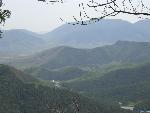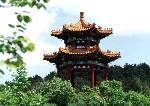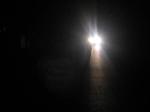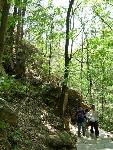- Getting around Lijiang. Dont stay in the Old Towns more than 2 days, there is nothing to do. KRISS Oct 9, 2013 05:46
- 2013 Beijing Temple Fair BENNYLAU Feb 26, 2013 03:29
- Malaysian traveling from KUL - LAX vis Shanghai PVG ZATI_DY Jan 3, 2013 20:15
The Hidden Sanctuary: Part 2
- Views: 6567
- |Vote: 1 0
- |Add to Favorites
- |Recommend to Friends
Into the Dragon's Lair
Groggy and caffeine-deprived and bobbing around on the bus, I didn’t know until we had arrived that we were destined for Jiu Long Shan—Nine Dragon Mountain. Once I heard the name, I perked up immediately.
It was my second sojourn into Ji Xian, Tianjin’s North County, a sprawling patch of countryside and mountain sanctuary that lies almost hidden between the urban meccas of Beijing and Tianjin. Ji Xian’s natural embroidery boasts inexhaustible finery, including 8 mountain peaks, a long slithering portion of the Great Wall, one of the oldest wooden structures housing a 16-meter tall statue of the Buddhist goddess Guanyin, one National Forest Park and a National Nature Reserve.
And we were headed to the Dragon’s Lair. Nine of them, to be exact.
You see, I didn’t know we were headed there because I was on the bus with 60 adolescent teens, and to be confined with that crew without sufficient fuel from my customary morning beverage (not to be found in the countryside village in which we had overnighted) was akin to riding a roller-coaster with loose bolts.
Unpredictable.
I was holding on until the ride was over. So, when the bus pulled to a stop after slaloming around the pits and craters in the dirt-road, I was ready to take on the Nine Dragons and their Mountain.
The Gateway
Nine Dragon Mountain is actually a complex of modest mountain ‘peaks’ that coil into one of China’s 187 National Parks. It lies about 20 kilometers north east of Ji Xian’s city center, a surprisingly beautiful arcade of parabolas undulating around the central gate of the Park.
The central gate sits solitary amidst the pines, a beacon that could convincingly warn away visitors from the Dragon’s lair with Dantean overtures of doom, were Dragons considered beasts of burden in the Land of the Rising Sun. Whatever message the gate hearkened was scaffolded by the sunny, clear blue skies and the impossible palette of greens that surrounded me and my 60 effusive charges as we scurried under the gate’s portal.
Nine Dragon Mountain is 2126 hectares of trees, boulders, flowers, wildlife, hills, and ridges slithering tango-hipped into nine little ‘peaks’, the most remarkable of which are JiuLong Mountain, Huanghua Mountain, and Limutai. At these hilltops you can find gazeboed pavilions, such as the Mind-Cultivation Pavilion and the Moon-Clasping Pavilion, overlooking Ji Xian’s mountainous topography. Quaint, well-kept trails wend through the hillsides and up the flanks of the mountains. Hundreds of varieties of trees, plants, shrubs, and flowers regale the hillsides, occupying the eye for hours. Peace blooms unhindered in this environment, as preserved a sanctuary as Nine Dragons deserve.
From Palm to Tip
Instead of climbing in peaceful silence, however, our merry group called out our whereabouts with more enthusiasm than a pack of wild dogs on a hunt. My students sang and chanted their way up to the Moon-Clasping Pavilion, clasping each other’s hands and shoulders, energized and enthused by the fresh air and the outdoors. An hour later they gushed and gossiped and gasped their way up to the Mind-Cultivation Pavilion, atop a taller peak. And later still, bellies full of lunch and saturated with sun, they charged up to yet another peak, an escarpment with strong winds and sweeping views.
Rather than one long exhausting climb up a singular peak, Nine Dragon Mountain offers a variety of mini-climbs which claw outward from the central palm of the Nine Dragon basin. After returning from each climb, hikers can rest their feet at one of the few refreshment stands before setting off again in another direction along the Dragon’s back.
Late in the afternoon our troops were recouping from their third ascent by licking ice creams in the shade of one of the refreshment stands. When they had finished, it was time for the fourth and final trek…only this time we were going below ground to ascend.
The Belly
Below ground? To ascend? Yes, you read that right. In the palm of Nine Dragon Mountain, beside the refreshment stalls, the gaping jaw of a Dragon waits idly for visitors to dare step into its stony jowls.
If you’re brave enough you’ll step in close to take a peek and see if you can see light—or anything—at the other end. But you won’t. All you’ll find is the Dragon huffing a stiff cold breeze that blows your hair back and an eerie whistling noise…laryngitis, perhaps. There was some edginess from the girls and a streak of gung-ho bravado from the boys as they donned their jackets and filed one by one into the narrow, dark passage. I followed.
Our voices quickly began echoing straight back into our own ears from the proximity of the stone tunnel walls. Our eyesight completely disappeared after we dipped down further into the tunnel, and the only way we knew where we were going was if we successfully grabbed the shoulder in front of us and trod on the heels of their shoes—or had our own trod on. Girls shrieked and boys bellowed, causing girls to shriek more and then giggle, ‘til all that could be heard was the raucous harmonics of adolescent vocal chords offset by the bass-line shuffle of our shoes skating over the gravel.
Then we began to ascend. This was a surprise, as it was completely dark and there was still nothing to be seen and too much to be heard with the adolescent adagios continuing in earnest. The tunnel was getting colder and colder the further we pressed into the Dragon’s esophagus and the smell of damp stone and earth was getting stronger. The students began to hush in anticipation; the claustrophobics in the group began to whimper slightly; and everyone began to wonder where and when this would end.
Then suddenly, like a match lit close to the face, a pinprick of light dazzled ahead (and above) us.
It was, literally, the light at the end of the tunnel.
Idle Wandering
The shuffling went faster—my heels stepped on a bit more urgently—as we climbed towards that eyelet of light. It grew larger and larger as we ascended: the temperature in the cave warmed, the smells of sun-softened sap and pine needles hit our noses until light was all that filled our vision, the black gaping cavern below us, and we emerged into the warmth and sunlight.
There were smiles and guffaws and chatter all around. The girls said they loved it but wouldn’t do it again; the boys were asking if there was enough time to get back and do it again. I didn’t know. As far as I, and the other teachers, could tell, we were somewhere on the backside of one of the ridges and there was only one small trail that led away from the tunnel. We followed it.
It took us through narrow ravines plugged full of trees and bushes, late-blooming flowers, and high slabs of rock-face. The trail seemed to flit and glide along the hillsides and basins as idly as a butterfly; taking us into the most idyllic apses of mountainside and along secretive paths overgrown with fragrant-smelling trees.
When the small trail finally dropped us off at one of the larger arteries that led back to the main gate, the sun was bearding the hillsides with long shadows. We climbed into the bus, sun-soaked and weary, and settled in for the sunset drive back home.
Travel Information
Late Spring, Summer, and Autumn are the best times to visit.
Trains leave from Tianjin daily at 730 and depart from JiXian at 1900. Tickets cost 20RMB. From Beijing, inquire at the train station.
Buses also run from Tianjin’s north east long-distance bus station. From Beijing, inquire at the long-distance bus station.
Local buses and tourist buses run from the JiXian station to the base of Pan Shan. Prices vary, but are cheap.
Pan Shan entrance ticket: 40 RMB
Chairlift: 50 RMB/round trip. 25/single trip.
Operating Hours: 900 to 1700
Hotel Information
In JiXian town the Yuyang hotel just north of the Drum Tower offers comfortable double rooms for 150 RMB. There are also cheaper options within the town and small chalets on the mountain. Rates vary seasonally.
Eating
There are plenty of local restaurants in JiXian town. There are also some restaurants on the mountain itself. These places all use local fresh ingredients and are fairly cheap.
*Gate photo and map photo from www.jlsfpark.com









 Copyright © 1998-2025 All rights reserved.
Copyright © 1998-2025 All rights reserved.